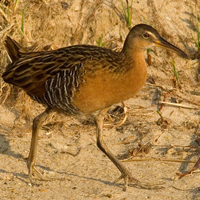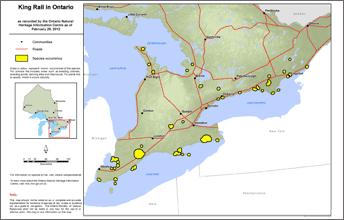King rail
Scientific name: Rallus elegans


Cover photos credit: Brian E. Small
Status
Endangered
"Endangered" means the species lives in the wild in Ontario but is facing imminent extinction or extirpation.
Date added to the Species at Risk in Ontario List
The King Rail was already assessed as endangered when the Endangered Species Act took effect in 2008.
What it looks like
The King Rail is Ontario’s largest rail, standing at 40 centimetres tall. It looks much like a giant version of the much more common Virginia Rail.
It has a long, slightly curved bill, long legs and a tall but very thin body, which allows it to move easily between cattail stalks – hence the expression “thin as a rail”.
The chest and neck are a dull cinnamon orange, while the back is a mixture of rust and brown streaks.
The sides of the body are blackish with thin, vertical white bars.
Where it lives
King Rails are found in densely vegetated freshwater marshes with open shallow water that merges with shrubby areas.
They are sometimes found in smaller isolated marshes but most seem to prefer larger, coastal wetlands.
Its nest is a dinner-plate sized platform made of plant material, placed just above the water in shrubs or clumps of other marsh plants.
Where it’s been found in Ontario
King Rails reach their northern limit in southern Ontario, where they are quite rare.
Recent province-wide surveys suggest there are only about 30 pairs left, the majority of which are in the large wetlands bordering Lake St. Clair.
Most of the remainder are found in several key coastal marshes along Lakes Erie and Ontario.
View a larger version of this map (PDF)
What threatens it
This species has suffered major declines throughout most of its range in interior North America over the past few decades.
Invasive species and the destruction and degradation of wetlands due to drainage, pollution and shoreline development have all played a role in their decline.
Additional threats in populated areas include predation by cats and collisions with cars.
Action we are taking
Endangered Species and their general habitat are automatically protected.
Recovery strategy
A recovery strategy advises the ministry on ways to ensure healthy numbers of the species return to Ontario.
Read the recovery strategy (December 14, 2016)
Government response statement
A government response statement outlines the actions the government intends to take or support to help recover the species.
Read the government response statement (September 12, 2017)
Review of progress
A review of progress made toward protecting and recovering a species is required no later than the time specified in the species’ government response statement, or not later than five years after the government response statement is published if no time is specified.
Read the report on progress towards the protection and recovery of 12 species at risk, including King Rail (2022).
Habitat protection
General Habitat Protection - June 30, 2008
What you can do
Report a sighting
- Report a sighting of an endangered animal or plant to the Natural Heritage Information Centre. Photographs with specific locations or mapping coordinates are always helpful.
- Bird Studies Canada is working to advance the understanding, appreciation and conservation of wild birds and their habitat in Ontario and elsewhere.
Volunteer
Volunteer with your local nature club or provincial park to participate in surveys or stewardship work focused on species at risk.
Be a good steward
- Private land owners have a very important role to play in species recovery; if you find a King Rail on your land, you may be eligible for stewardship programs that support the protection and recovery of species at risk and their habitats.
- If you have wetland habitat on your property, you can help King Rails and other marsh birds by keeping or establishing natural buffers along the shoreline, avoiding the placement of bright lights that shine into the marsh, and keeping pets from running loose.
Report illegal activity
Report any illegal activity related to plants and wildlife to
Quick facts
- The King Rail is a very secretive and shy bird that is most active at dawn and dusk; it is rarely seen, and is most often located by voice - it has a variety of calls but the most distinctive is a deep, rhythmic monotone grunting of “whah whah whah whah whah”; another call is a repeating “kik-kik-kik”.
- King Rails need open water to find food, so they migrate to the big coastal marshes of the southern US to spend the winter.
- King Rails feed mostly on crayfish and crabs but will also eat fish, insects, and some plant seeds.
- During courtship, males present crayfish or small crabs to females in their bill.
